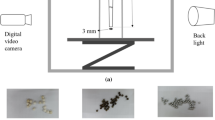Abstract
The generation, insertion, pressurization and use of oil-based tracer particles is qualified for the application in heated flow facilities, typically hypersonic facilities such as Ludwieg tubes. The operative challenges are to ensure a sub-critical amount of seeding material in the heated part, to qualify the methods that are used to generate the seeding, pressurize it to storage tube pressure, as well as to test specific oil types. The mass of the seeding material is held below the lower explosion limit such that operation is safe. The basis for the tracers is qualified in off-situ particle size measurements. In the main part different methods and operational procedures are tested with respect to their ability to generate a suitable amount of seeding in the test section. For the best method the relaxation time of the tracers is qualified by the oblique shock wave test. The results show that the use of a special temperature resistant lubricant oil “Plantfluid” is feasible under the conditions of a Mach-6 Ludwieg tube with heated storage tube. The method gives high-quality tracers with high seeding densities. Although the experimental results of the oblique shock wave test differ from theoretical predictions of relaxation time, still the relaxation time of 3.2 μs under the more dense tunnel conditions with 18 bar storage tube pressure is low enough to allow the use of the seeding for meaningful particle image velocimetry studies.













Similar content being viewed by others
Notes
http://www.topas-gmbh.de/dateien/prospekt/210prspe.pdf (accessed 17.07.2013).
http://www.tsi.com/fast-mobility-particle-sizer-spectrometer-3091/ (accessed 17.07.2013).
http://addinol.de/oilfinder/oil_details.php?id=786 (accessed 17.07.2013).
References
Casper M, Stephan S, Windte J, Scholz P, Radespiel R, Scharnowski S, Kähler CJ (2012) Hypersonic PIV in a Ludwieg Tube Wind Tunnel at Mach 5.9, AIAA 2012–3197. In: 28th aerodynamic measurement technology, ground testing, and flight testing conference, New Orleans, USA, June 25–28
Estorf M, Wolf T, Radespiel R (2005) Experimental and numerical investigations on the operation of the Hypersonic Ludwieg Tube Braunschweig. In: Proceedings of the 5th European symposium on aerothermodynamics for space vehicles., ESA SP-563:579–586
Frobese D-H, Brandes E (2011) Report on explosive limits in hypersonic windtunnel “HLB”, unpublished
Glatzer C, Meiss J-H, Meinke M, Schröder W (2011) Numerical investigation of the near wake of generic space launcher systems at transonic and hypersonic flows. In: 4th European conference for aerospace science(EuCASS). St. Petersburg, Russia
Godfrey D, Herguth WR (1995) Physical and chemical properties of industrial mineral oils affecting lubrication, part 2. J Soc Tribol Lubr Eng 51(6):493–496
Haertig J, Havermann M, Rey C, George F (2001) PIV measurements in Mach 3.5 and 4.5 shock tunnel flow. In: AIAA 2001–0699, 39th aerospace sciences meeting and exhibit, Reno, USA, Jan 8–11
Havermann M, Haertig J, Rey C, George A (2002) Application of particle image velocimetry to high speed supersonic flows in a shock tunnel, 11th international symposium on application of laser technology to fluid mechanics, Lisbon, Portugal
Havermann M, Haertig J, Rey C, George A (2008) PIV Measurements in Shock Tunnels and Shock Tubes. Particle Image Velocimetry, Topics in Applied Physics 112(2008):429–443. doi:10.1007/978-3-540-73528-123
Humphreys WM, Rallo RA, Hunter WW, Bartram SM (1993) Application of particle velocimetry to Mach 6 flows. In: 5th international conference of laser anemometry, advances and applications, Veldhoven, The Netherlands, August 1993
Kähler CJ, Sammler B, Kompenhans J (2002) Generation and control of tracer particles for optical flow investigations in air. Exp Fluids 33:736–742. doi:10.1007/s00348-002-0492-x
Lang N (1999) Investigations of the flow tracking capabilities of tracer particles for the application of PIV to supersonic flows. Notes Numer Fluid Mech 72:266–273
Melling A (1997) Tracer particles and seeding for particle image velocimetry. Meas Sci Technol 8:1406–1416
Ragni D, Schrijer F, van Oudheusden BW, Scarano F (2001) Particle tracer response across shocks measured by PIV. Exp Fluids 50:53–64. doi:10.1007/s00348-010-0892-2
Schrijer FFJ, Scarano F, van Oudheusden BW (2006) Application of PIV in a Mach 7 double-ramp flow. Exp Fluids 41:353–363
Tedeschi G, Gouin H, Elena M (1999) Motion of tracer particles in supersonic flows. Exp Fluids 26(4):288–296. doi:10.1007/s003480050291
Ünalmis ÖH, Hou YX, Bueno PC, Clemens NT, Dolling DS (2000) PIV investigations of role of boundary layer velocity fluctuations in unsteady shock-induced separation. In: AIAA 2000–2450, 21st AIAA aerodynamic technology and ground testing conference. Denver, USA, June, pp 19–22
Wernet JH, Wernet MP (1994) Stabilized alumina/ethanol colloidal dispersion for seeding high temperature air flows. In: Proceedings of the ASME symposium on laser anemometry: advances and applications, Lake Tahoe, NV, June 19–23
Acknowledgments
The work has received funding by the German Research Foundation (Deutsche Forschungsgemeinschaft, DFG) within the framework “Sonderforschungsbereich Transregio 40, SFB-TR 40” (Technological foundations for the design of thermally and mechanically highly loaded components of future space transportation systems). The authors like to acknowledge H. Rochlitz for contributing to the measurements in the HLB, D.-H. Frobese and E. Brandes (Physikalisch Technische Bundesanstalt, PTB) for fruitful discussion regarding the estimation of the safety measures and explosion limits and I. Kirsch and E Uhde (Fraunhofer Wilhelm-Klauditz-Institut, WKI) for providing the equipment and contributing to the measurements of particle size distribution.
Author information
Authors and Affiliations
Corresponding author
Rights and permissions
About this article
Cite this article
Casper, M., Stephan, S., Scholz, P. et al. Qualification of oil-based tracer particles for heated Ludwieg tubes. Exp Fluids 55, 1753 (2014). https://doi.org/10.1007/s00348-014-1753-1
Received:
Revised:
Accepted:
Published:
DOI: https://doi.org/10.1007/s00348-014-1753-1




